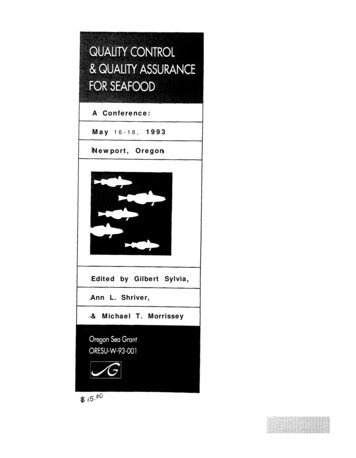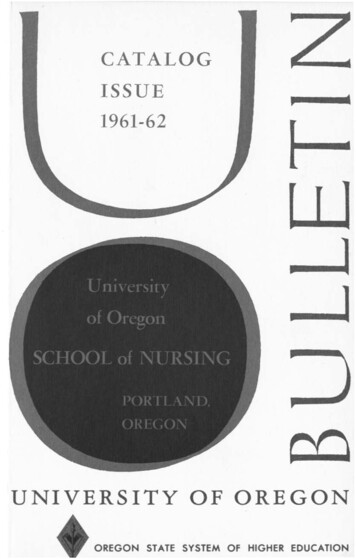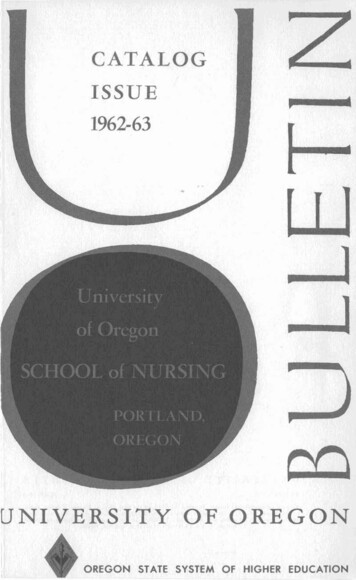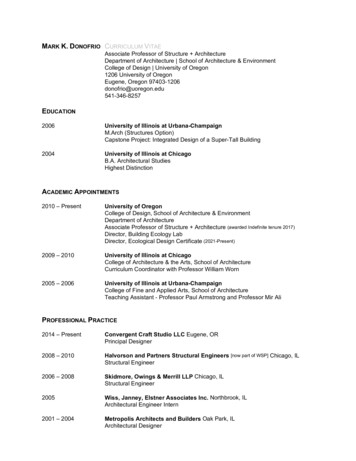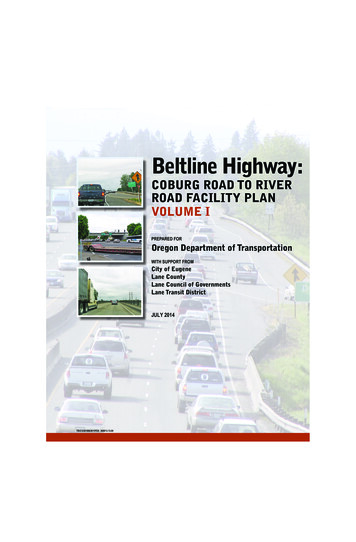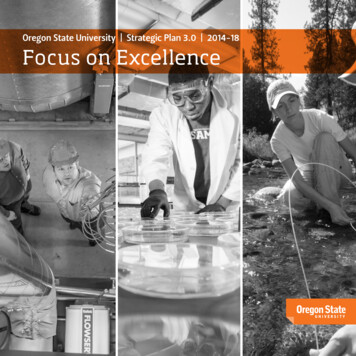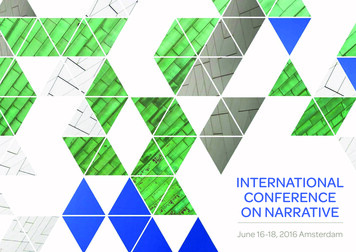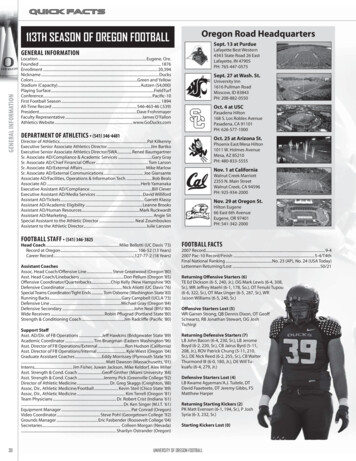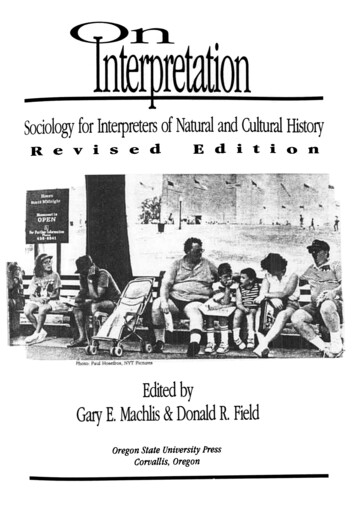
Transcription
.RevisedEdOregon State University PressCorvallis, Oregonii0n
Monster Time and OtherEthnographic Insights at WupatkiNational Monument(1989)Robert T. Trotter, II
130Introduction"Humans carty their cultural values everywhere they go, and act\.out of those values, whatever they do. This makes it useful to ow ,.,the diversity of beliefs and values people bring to a subject whendesigning an interpretation program. National parks, museums,andall other cultural eventsare venues where interpretation specialistsmust accommodate their messagesto a wide variety of beliefs andbehaviors in order to get infonnation acrossto the public. Ethnography has been widely used asa researchmethod in the social sciencesand is becoming an increasingly important mechanism to assistinterpretation programs.JamesSpradleyprovides a cogent defInitionof ethnography:Ethnography. .is a systematic attempt to discover the knowledgea group of people have learned and are using to organize theirbehavior (Spradley and McCurdy 1972:9).This chapter presents a case study of the ways in whichethnographic researchcan be used to improve cultural and prehistoric interpretation. The author and his studentswere invited to doan ethnography of visitor behavior at Wupatki National Monumentnear Flagstaff,Arizona, in order to improve the interpretation at theparkl. When the findings from that research were shared withinterpretation specialists around the country, we discovered thatmuch of our specific data can be generalized to other parks, to1. The basis for this chapter is a field school conducted during the summer of 1989at Wupatki National Monument as one element in an existing cooperativeagreementbetWeenthe Monument and the Anthropology Department at NorthernArizona University. The project was funded by a grant from the U.S. Departmentof Education and included a companion archaeologicalfield school at WupatkiRuin. In addition to the researchquestions being answeredby the field schools,thetWo field schools were designed to provide researchtraining to undergraduateminority students,to encouragethose studentsto seekgraduatecareers.Both fieldschoolslasted sevenweeks. Six studentsreceived ethnographic field training. Theirinstructionincluded direct observationand recording of visitor d note developmentand management,ethnographicanalysis,and the presentationof ethnographic data. Their research education wasdirected by the author and supported by tWo anthropology graduate assistants,Ms.Duffie C. Westheimer and Ms. Lisa M. Leap. The studentswere asked to address
MonsterTime and Other EthnographicInsights-museums, and to other organizations that interpret human prehistory and other aspects of human culture to visitors from manydifferent backgrounds.The chapter is organized as follows. First, the researchmethodsemployed in the study are briefly described, along with a briefbackground on the Monument. Next, a general profile of visitors toWupatki is presented. Since a significant portion are internationalvisitors, a detailed proflle of one group is included, to demonstratethe understanding that can be gained through the ethnographicapproach. Next, visitor behavior is described, focusing upon thegender roles, family dynamics, and vandalism found at the site.Visitor needs and expectations are then explored, and the chapterends with the implications of these results for interpretation.Research MethodsOur ethnographic research design was directed at understanding the behavior of visitors in and around the visitor center atWupatki Ruin and at two other outlying archaeological sites whichare easily accessible to visitors. Decisions on where to concentrateour research and the kinds of information to collect were guided bytwo initial steps in the research process.First, the author conducted two focus group sessions with parkmanagement and personnel, to determine the most pres.sing information needs that could be met using an ethnographic researchapproach. The Park Service personnel decided that their greatestneeds were in the areas of interpretation and the control of behaviordeleterious to the park resources. They requested that the researcheffort determine how long people stay at the ruins, where they go,what interests them, what types of interpretation work well, andthe general interestsof ParkServicepersonnelwhile selecting their researchtopics.The focused topics that they chose were visitor interest and beliefs about themonument (Cha 1989), the interaction between Park Service and visitor beliefsabout boundaries and pennissible behavior (Hopkins 1989),family dynamics atthepark (Winkfield 1989),visitor center information servicesand employee interactionwith visitors (Brown 1989), German tourists at an archaeological park (Orozco1989),and behavior at outlying sites (Valero 1989).
On Interyretation132how visitors generally behave. They decided that they would mostlike to know the answers to two questions. What do people reallywant to know about the ruins?Why do people vandalize the ruins?Second,a two-week period of general observationswas undertaken. This exploratory researchphase allowed us to discover andmonitor the most common patternsof visitor behavior. The ethnographers periodically timed visitors, unobtrusively followed theirmovements through the ruin, listened to public conversations,andasked a few preliminary questions. From these observations wedevised questions to ask the visitors to gain more in-depth information about their experiences in the park. We pooled and discussedour findings, to provide everyone with the broadest view of visitorbehavior at the park. From this preliminary work, we selectedindividual topics for additional observations and ethnographicinterviewing. The next four weeks were spent completing thesespecific research assignments.At the end of the researchproject,team members presented their findings to Park Service personneland provided written reports for further reference.Background on Wupatki National MonumentWupatki National Monument receives approximatelyone quarter million visitors each year. The heaviest visitation is during thesummer and on holidaysa steady, but reduced,during other seasons. The park maintainsflow of visitorsat all other times. Wupatkiisknown for its rich archaeologicalresources, which include 2,668sites with historic significance within a 53-square-mile boundary. Itis administrativelyand ecologicallytied to nearbySunset CraterNational Monument.Wupatki is designated, by park personnel, as an "on-the:-way-to"park. While it is a destination park for local residents, a significantportion of its visitors are either on the way to or are coming backfrom the Grand Canyon or other parks in the southwesternUnitedStates. Some visitorsmonu-are on a grand tour of archaeologicalments in the southwesternUnited States, with Wupatkibeingwedged among better known archaeological parks such as Canyonde Chelly or Mesa Verde.
133WupatkiEntrance,additionalis not easily accessible. Visitors must enter at the Southpass by Sunset Crater National Monument, and drive an18 miles into the desert to Wupatki. Or, they must comein the North Entrance and drive an approximatelyreach the visitorcenter from that direction.36 miles and tends to discouragefact, every day we observedequal distance toThe total loop is aboutthe more casual type of visitors. Inpotentialvisitorsturningaroundandleaving the park, after having driven 15 miles and being within a mileof the first ruin in the park. It takes about 45 minutes to simply drivethroughavailablethe Wupatkiboundaries,sites, so visitorsin the park, even whenwithoutstoppingat any of thefeel they have spent a great deal of timethey ,don't get out of their car.General Findings on Wupatki VisitorsThe student ethnographerseducatedand are commonlyfoundthat Wupatkimoreinterestedvisitors are wellin archaeologicalhistory than the general population. Therefore, the overall profile ofvisitors to the park differs from that of visitors to parks that are moreeasily accessible, and parks that are primarydestinationparks, suchas the Grand Canyon.Wupatki visitors are predominantlymiddle-class Anglo-Americans. This was first determined by direct observation of key socialmarkers,such as dress,materialetc.), and speech patterns,items (cars, camera equipment,and later confirmedby direct questionsabout background,employment,and educationalstatus duringinterviews. The second largest contingent at Wupatki is of foreignvisitorsfrom Europeand Asia. The most commonare those fromGermany, Austria, and Switzerland. Numbers of French-speakingtourists also visit the park, as well as a sprinkling of people fromJapan. One of the smallest contingents is of visitors from variousminority groups in the United States. The students observed Black,Native American, and Hispanic visitors but they are the exception.This trend had been noticed by park personnel and was of concernto them. One of the questions we had hoped to address was whythe numberof Native Americanthe small numbers preventedand Hispanicany extensivevisitors is so low, butexplorationof this issue.
134On IntetpretattonThe averagelength of stayat Wupatki Ruin and the visitor centeris lessthan thirty minutes. In this time visitors typically move from theparking lot into the visitor center, look at the displays and makepurchases,and then move beyond the visitor center to the archaeological site itself. About 10 percent of the visitors circumvent thevisitor center and go directly to the ruin. Beginning at the overlookto the ruin, people choose among several routes which shorten orlengthen their stay.Some visitors never make it out of the visitor center. They usethe toilet facilities, make purchases, ask directions, and return totheir cars. It is not uncommon for some of the teenage visitors to noteven get out of the car in the parking lot, while members of theirfamily group visit the ruins.About 20 percent of those who visit the ruin walk out to theoverlook, read part or all of the trail guide, and return to the visitorcenter or directly to the parking lot. The restgo at leastpart way intothe ruin. As many as one-third of the visitors missthe sign that pointsthe direction to take around the ruin, correspondingto the trail guidenumbers. They end up going around the ruin in reverseorder. Mostaccommodate rapidly by reading the trail guide backwards, but thisdoes cause some confusion.There are several decision points during the tour where visitorseither continue on or skip some part of the tour and return to thevisitor center. The fIrst decision point is at the overlook, whichprovides a panoramic view of the main ruins, an amphitheater,a ballcourt, and a small geological formation called the blow hole2.Somepeople stand at the overlook and read the Wupatki trail guidewithout getting closer than about 100yards to the ruin. The secondmajor decision point is whether or not to visit the amphitheater.This2. The blow hole is a small crack in the ground, which has been bricked over witha small grate to prevent accidents. Under the opening are thousands of cubic feetof cracksin the rock formation below Wupatki. The blow hole gets its name fromthe fact that the cyclical heating and cooling of air at Wupatki causes air to eitherblow strongly out of the hole, or to be sucked into it with considerableforce. Visitorsoften stand on top of the crack,to allow the outflow to actasa natural air conditioneron very hot summer days.
135adds 50 yards to the tour, and it is a moderate climb. At 5,000 feetin the desertheat, these decisions are important. The third decisionis whether or not to go from the end of the major ruin complex downto the ball court and blow hole. This adds at least 150 yards to thetrip, with no shade available. Those who do visit the lower part ofthe monument are among the group whose visit lastslonger than theaverage. In almost all casesit is common for the visitors to read thesectionsof the trail guide that describethe areasthey are not visiting,while looking at them from a distance.German Touristsin the SouthwesternDesertThe general demographic surveys done in the park, along withvisitor logs, indicate that approximately 20 percent of the Wupatkivisitors have a Germanic culrural background. One of our srudentethnographers developed an interest in these visitors when heobserved that almost every rental car in the visitor centerparking lotthat had California license plates disgorged a group that was speaking German (Orozco 1989). He began to wonder why Germanswere the most frequent tourists, rather than an even mixture ofpeople from other Europeancountries. British and]apanese visitorswere present on an irregular basis during the summer, and theytended to arrive by bus. The Germans arrived every day by the carload.One of Orozco's findings was that many of the Germanvisitorshad developed an interest in American Indian culrures, and in U.S.prehistory, on the basis of reading children's books written by aGerman author named Karl May. May wrote a large number ofhighly romantic books about Indians, and their treatment by thedominant U.S.culture, at about the turn of the century. Many of thevisitors, especially those over forty, came to the Southwest withexpectations of experiencing contact with Indian groups, and toplay out childhood dreams.The younger visitors were less likely toexpect things to be as Karl May portrayed them, but nonetheless,many had read his books and gained an interest in the regionbecauseof them. Orozco also found a general desire on the part ofthese visitors to have a greatly expanded German language trailguide. Most of the Germans visit a variety of archaeological sites
On Interpretation136throughout Arizona, New Mexico, Colorado, Nevada, and California. They are very well educated, as a group, and have a high levelof interest in U.S. prehistory. They commonly read books aboutthe Southwest prior to traveling to the region, and purchase otherbooks during their travels. They also receive large volumes of materials from German travel agencies. The existing interpretivematerials at Wupatki, and most of the other archaeological parksthey visit, provide far less detail than they would prefer.Visitor BehaviorGender Rolesand Family DynamicsVisitors play out a number of middle-class American culturalpatterns as they tour the ruins. The most visible patterns areconsistentdifferencesin genderroles, age-relatedrole behavior, anddifferences in the family dynamics of visitors. These culturaldifferences have important implications for interpretation.After exiting the visitor center, tourists pass a box on a postwhich contains trail guides for a self-guided tour ofWupatki Ruin.Most single individuals pick up the trail guide, and tour eachnumbered station independently of other visitors. If the visitorscome in a group, then one or more members of the group pick uptrail guides and move around the ruins more or less in contact withone another, depending on the composition of the group and thefactors described below.Couplesand families with children tend to take a single trail guide(although children occasionallydemand to have their own separateguides). Usually one of the children or one of the adult males in thefamily takes the trail guide out of the box and carries it to the firststation, an overlook of the ruin. At the overlook, the trail guide ishanded over to the "centralfemale" in the group, who begins to readthe guide to everyone in the contingent. We designatedthis personthe "central female," becausein groups where more than one adultfemale was present only one normally took on the role describedbelow. Shewas typically the oldestfemale, unless the oldest was inher sixties or older. This woman seemedto take the lead in sharinginformation about the ruin with the rest of the family. At the same
o!,ster T!!!!!!-!!nd Other EthnographicInsights137time, the "central male" took on the role of photographer, recordingthe visit with either a still or a video camera.If he used a still camera,he simply alternated between taking photographs and listening tothe female who was reading the guide. If he used a video camera,he normally recorded the sound of the trail guide being read as hepanned acrossvarious scenesin the ruin that corresponded to eachsectionof the trail guide. This division of labor continued throughoutthe ruins.This gender-typed behavior is not universal. Males occasionallyread the trail guide out loud to the family or group, and some womendid a considerable amount of photography. But these were lesscommon. The few times we observed males reading to families,mostsounded asif they did not have much practicereading out loud.This probably ties into the fact that it is much more common inAmerican families for mothers to read to their young children thanfor fathers.In a single-sex group, it is most common for everyone to takea trail guide, but to proceed around the ruin together. Occasionally,especiallywhere the group was two or three females,one individualwould read the trail guide out loud, in the samemannerasin a familygroup. However, it was more common for individuals to readsilently at eachmarker, and then to make commentsto one anotheror ask additional questions raised by the trail guide at that point intheir collective experience.Overall family dynamics were explored through interviews(Winkfield 1989). We found that families differed greatly in theamount of control exerted over various membersof the group. Theyalso differed significantly in the purpose they expressed in visitingthe monument and this often correlated closely with observedbehavior in relation to social control.The behavior of children in these family groups depends on thelevel of social control that the parents exert on them. At one end ofthe spectrum the children stand with the guide book reader and thephotographer at each station, listening and participating in a groupexperience of the ruin. At the other end of the behavioral spectrum,the children range far ahead of the parents, paying no attention to
138On Interpretationthe adult roles being acted out around them, and often straying fromthe trail boundaries. If the family was visiting the monument as onestop on their vacation, they tended to maintain far lesscontrol of thechildren, even encouraging behavior beyond the boundaries ofacceptable behavior in the park. But if one of the main purposes forthe visit was to instill a sense of history, to educate the family andthe children in particular, then the parentstended to show respectfor the ruins and to demand the same respect from their children.Thesefamilies seemedto be more concerned about the preservationof resourcesthan those whose purpose was solely entertainment orrelief from the boredom of a long drive. These differences havesome direct bearing on interpretation in the parks.The behavior in the educationally oriented families was relatively consistent.Thesefamilies nearly always took a copy of the trailguide, and deliberately kept the family together as the guide wasread at each numbered point. If the family had small children, oneor both parents normally held their hands or carried them. Theseparents tended to be proactive in teaching the children properbehavior before they had a chance to misbehave, explaining tothem, for example, why they should stayon the trails and not disturbthe ruins. These families also tended to be very responsive to thepresence of rangers and were eager to talk with them and askadditional questions.The behavior of families lacking an educational orientationdiffered in nearly all respects.There were far fewer attemptsto keepthe family together; individuals were allowed to experience the ruinon their own, at their own pace. Far less behavioral control wasexhibited, and it was nearly always reactive. When the trail guidewas read, it was rarely to the whole family group. These differencesin family dynamics suggestthat at leasttwo different approachestoencouragingappropriate behavior in visitors and their children needto be attempted by Park Service personnel.The following sections provide specific case study materialderived from the ethnographies.These include fmdings on vandalismand monsterchildren; visitorneeds,expectations,and interpretivepreferences; and the implications of our research.
M nsterTim dOt h o raphic Insights139Vanda1ismAll of the ethnographers were alerted to watch for, categorize,and understand vandalism at the monument. This sometimescreated a delicate balance between participant observation andintervention. We needed to see what was happening, in order torecord it and understand it for appropriate park staff intervention inthe future. We also were concerned for protection of the resource.One of the studentsfocused on the issue of social and physicalboundaries in her ethnographic research.Hopkins (1989)describesboundary ambiguities and misbehavior of visitors in a tour ofWupatki Ruin. She also identifies nine forms of ruin abuse, andprovides profiles of the location and frequency of these forms ofvandalism, along with recommendations for reducing both theirseverity and their frequency. Table 1 is an adaptation of Hopkins'sfindings on vandalism.The anthropological literature would predict that the strongestagreementabout the size, shape, and purpose of social boundariesin the parks would exist among Park Servicepersonnel, since theyshare a single corporate culture, while visitors do not. It would alsopredict that many of their beliefs about theseboundaries would notbe shared by visitors until, or unless, visitors are educated aboutthem.This is a classic situation, found in many instances where aprofessional group controls special cultural information and interacts with a public which lacks access to this information. It iscommon for the professional group to believe that their cognitivepatternsare shared.This is why doctors confuse their patientswhenthey use medical jargon instead of normal social language. In thesame vein, we discovered a Park Service culture that includes arelatively well shared cognitive map of the "proper" boundaries atthe monument. As predicted, it is not adequatelyshared by visitors.Hopkins found this creates problems of a number of varieties,including confusion over boundaries in the monument.No culture is completely homogeneous.We found variation inbeliefs about appropriate boundaries among various groups ofindividuals working in the park. The full-time and seasonal staff
On Interpretation140Table 1. Types ofvandalism at Wupatki Ruin.PerpetratorsType of vandalismFrequencyGeneral public Walking on impacted areas, off trail;leaning on ruin sWalking in ruins; climbing walls;picking up and throwing objects;graffitiTouching artifacts; sitting on walls;walking on wallsPhotographers Walking off trail; posing people inrestricted areasVerycommonVerycommonCuriousWalking off terrain into restricted ruinQuiteareascommonNature loversWalking far off trailCommonCollectorsWalking off trail; going into backUncommoncountry; picking up artifacts,rocks,& other specimenswithout permissionWriting marks or ruining ngcattle; offroad vehicles,etc.Commonshared professional orientations and standardsthat tended to makethem relatively consistentin defming both physical and behavioralboundaries. More variation was noted between thesepeople and thevolunteer staff. But all of the staff controlled tacit knowledge thatwas not easily accessibleto visitors. As one of the studentsstated,inconsistenciesin the beliefs of the staff, combined with a lack ofdefinition of some of the boundaries, make it easyfor tourists to belegitimately confused about what is or is not permitted.Loopholes also allow deliberately destructive individuals tomanipulate the situation, since the staff is anxious to maintainpositive relationships with the public. Hopkins cites the examplethat the people who visit the oudying ruins, where there are few
Monster Time and Other Ethnographic Insights141clear boundaries, expect to have the same freedom of accessat themain ruin. They occasionally become angry when confronted byofficial requests to not behave at Wupatki in ways that wereuncontrolled at Wukoki or the Citadel. The inconsistency of thecontrols placed on visitors leadsto confusion and other more seriousproblems, permitting deliberatelydestructiveindividuals to manipulate the situation, since the staff is anxious to maintain positiverelationships with the public. The information provided in Hopkins'sreport actsas an excellentmodel for similar studies at other sitesandcould be useful for establishingand maintainingworkable boundarycontrols for archaeologicalparks.Monster Time at Wupatki RuinOne type of vandalism that occurred regularly in the parkbecame the focus of much interest during our research. Wediscovered that Wupatki Ruin had a special time of day that welabeled "monster time." This was a very predictable form of childmisbehavior which occurred in the ruins every afternoon.Monster time begins at approximately 3:00 P.M.and lasts until4:00 or 4:30 P.M.During that time period at least one child, andfrequently more, would be observed actively climbing all over theruin and getting into areasthatwere far outside of appropriate visitorboundaries, despite the numerous signsrequiring visitors to stay onthe paths, stay off the walls, and not disturb the ruins.We developed a basic profile of the "monster child." The mostcommon monster was a young Anglo male, between the agesof 10and 13, distinguished from non-monster children by severalcharacteristics. Monster children tend to wear clothing that hasbright colors, or they are dressed all in black. Their t-shirt normallyhas a logo with a rebellious message.The monster child visits theruin with his parents, but quickly leavesthe family group. Monstersmove very rapidly into the ruin and begin cutting trails, walking onwalls, and moving into restricted rooms in the middle of the ruin.They continue to exhibit this behavior, ignoring any parentalcomments, throughout their visit. The monsteralways appearsto bevery full of energy at a time when the rest of the family is dragging.The parentstend to lag far behind, probably becausethey have been
142On Interpretationcooped up in a car with a monster child for the entire day, or longerif they are traveling on a family vacation. In no casedid we observefamily members effectively controlling the monster'sbehavior. Mostof the time their parentswere not close enough to comment to themanyway, let alone close enough to control their behavior. The onlycondition that appearedto determonsterbehaviorwas the immediatepresence of a uniformed ranger.Monster children tend to take signs very literally, as a manipulation device. For example, we interviewed one monsterchild after hehad jumped three walls and was climbing up into the middle of theruin. He belligerently stated that he had strictly obeyed the sign thatsaid, "please stay off the walls." He had carefully jumped the wallsand not touched a single one of them. Another child said, when askedto get off a wall, that the sign which said to stay off the wall was in anentirely different part of the ruin (about 25 feetaway), not right whereshe was sitting. She felt the sign didn't apply to this particular place.This instance of a female monster child was unusual. Monsterchildren are rarely female. We did observe instances of femalemonster behavior, but almost all were accompanied by males thatfit the primary monster profIle. Their behavior in most casesappeared to be tagged to male monster behavior, rather than beingself initiated. Most girls were simply accompanying a monster maleon his run through the ruins.The ethnographers also noted monster behavior at the outlyingsites, but it was not as easyto cOnflfffi the timing of theseevents. Itdid become apparent that some of the children who performedmonster activities at Wupatki exhibited the same type of behaviorat outlying sites. This was confirmed by direct observation whenstudentsmoved from one site to another at the end of the day, firstobserving monster behavior of a particular child at an outlying ruin,and then, when they returned to the visitor center, observing thesame child in the Wupatki ruins. It was also confirmed by indirectevidence as the students compared notes which allowed them torecognize similar individuals who were observed in two differentlocations by different ethnographers.
143Vis tor Needs and Expectationse student ethnographers spent several hundred hours intervie ing visitors about their interests and interactions with themo ument. In addition they recorded natural conversations betwe n visitors, between visitors and Park Service personnel, andbe een visitors and other visitors. This allowed us to explore thetyp s of questions that visitors would like to have answered aboutarchaeologicalin general,in particular.Thisi ' ars to be anruinsexcellentguide forandtheWupatkidevelopmentof interpretiveapmat rials, and for training Park Service personnel for interpretivedu' s. The areasnoted below are describedin more detail in severalof e ethnographic reports, and especially in Cha (1989).ifesty/esne of the majortopics of interestto visitors is finding out detailsabo t the lifestyles of the people who lived at the site. Theirque tions provide an excellent profile for the development of trailgui es at any archaeological park, and for the types of interpretivemat rial that can be transmitted by park personnel.The mostcoon things visitors wanted to know were:1. The physical characteristicsof the people at Wupatki. Whatdid e people look like? How big were they? (Some thought theymu t have been very small because of the small doorways atWu atki, not realizing that small doorways lose less heatduring the er).1
Arizona University. The project was funded by a grant from the U.S. Department of Education and included a companion archaeological field school at Wupatki Ruin. In addition to the research questions being answered by the field schools, the tWo field schools were designed to provide research training to undergraduate minority students, to encourage those students to seek graduate careers. Both .
